GENKI KITE
By Mike Dallmer
When I first decided to build this kite I was looking for a low wind steady flying kite that could be staked and left to fly all day. What resulted was better than my expectations, with a wind range up to 20 mph. The plans that follows were created for a workshop that I will give as part of a continuing series of workshops that South Jersey Kite Flyers give. They are tested and proven to work, but anyone with any problems can feel free to contact me. I recommend that graphics be put on the sail after it is cut out but before assembly so that all the necessary reinforcing patches can be color coordinated. Good luck and building.
| GENKI PARTS LIST | |||
| Description | Quantity | Description | Quantity |
| .1800 Machined End Cap (MEC) | 4 | .1800 Vinyl End Cap | 4 |
| Machined Nock (YSP-63) | 2 | 41” Fabric (I used 3/4oz Icarex) | 4.5 yd |
| .3150 x 54” Carbon Tube | 1 | Reinforcement Fabric | 0.5 yd |
| .2300 x 37.5” Carbon Tube | 2 | 100# Bridle Line | 30 ft. |
| .1800 x 29.5” Carbon Tube | 7 | ½” Aluminum Ring | 3 |
| .1800 Connector | 4 | ½” Edge Binding | 14 yd. |
| Do Hickey (YSP 19) | 2 | Line Tensioner | 1 |
| 3/32” Round Elastic | 1 yd. | ||
Genki Building Instructions:
Cut out:
- Sail. All measurements are in inches.
- Reinforcements are based on a 3” diameter circle.
- 2” x 14 yd strip, for edging binding.
- 2” x 35” strip, for bridle loops for bridle loops.
- 2” x 30” strip for pockets. Cut into 2 ½” long pieces.

Preliminary:
- Edge Binding:
A) Fold each edge of 2” x 14yd over approximately 3/8” (I do this by ironing).
B) Then fold this in half (again, I iron it). This makes a double fold tape. - Bridle loops:
A) Fold the 2” x 35” strip in half.
B) Fold it again in half.
C) Fold it again in half.
D) Fold it again half, winding up with a strip approximately ¼” wide.
E) Sew a straight stitch the entire length of this.
F) Cut four 4 1/2” lengths. This makes the bridle attachments.
Assembly:
- Sew Reinforcements
where located on drawings.
A) Make sure that when the Reinforcements are sewn on to the Keels that one Reinforcement is sewn to each side of the Keel. - Sew Edge Binding around entire edge of Sail. Start in the center of one of the 1” Marks (where spars will eventually be located.
- Sew bridle attachments
to the Keel, onto the Reinforcement (Figure 1)
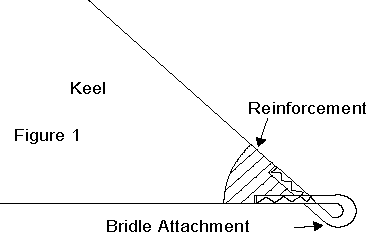
A) Fold in half lengthwise.
B) Line up along edge of Keel leaving ½” exposed for bridle attachment.
C) Sew onto Keel using triple zigzag. - Sew Edge Binding on all four Keels, making sure bridle attachment points are exposed. Do not put Edge Binding where the Keel will be sewn into Sail. (1/2” mark)
- Lower Sail Corners
A) Thread 1 Machined End Caps (.1800) onto a piece of 5” long 3/32” Elastic.
B) Tie ends together
C) Thread a 4” piece of Edge Binding through loop in elastic
D) Fold in half
E) Sew onto a lower corner of Sail pointing towards top center. Make sure you are sewing on side with reinforcement. (Figure 2)
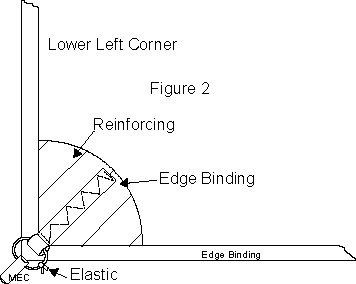
F) Repeat Steps A-E for other corner.
G) Fold 8 of the 2½” x 2” strips so you wind up with 2” x 1½” pockets
H) Sew the 1½” sides on edges.
I) Attach to Sail over Reinforcement so that it covers the edge binding holding the elastic. Elevate it a little so that the spar fits in it. (Figure 3)

- Upper Sail Corners
A) Same as Lower Sail Corner except no Machined End Caps are used and the Edge Binding points to center of sail. (Figure 4)
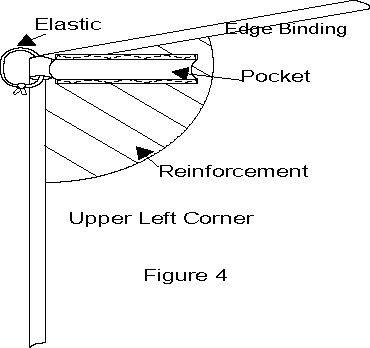
- Tip Spreader Center Pocket
A) Take 2 more of the 2” x 1½” pockets and sew them on Reinforcement #6 with open end pointing towards Reinforcements 2 & 4. - Spine End Caps
A) Thread 1 Machined End Caps (.1800) onto a piece of 5” long 3/32” elastic.
B) Sew this onto the bottom of the Sail between the 1” marks leaving about ½” exposed on each side. I use a triple zigzag stitch. Sew this in the front side of Sail. (Figure 5)
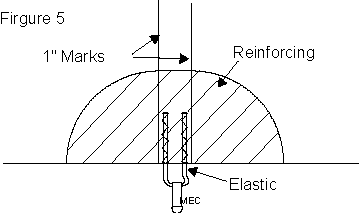
C) Repeat for other side. - Spreader Spar Holders
A) Take 1¼” of Edge Binding and tread it though one of the ½” aluminum rings.
B) Measure 10” down from the top of the sail at the 1” marks; this should fall in the center of reinforcing #4.
C) Sew the edge binding between the 1” marks, ½” on each end. (Figure 6)

D) Repeat for other side. - Top Pocket of Tip Spreader
(Figure 7)
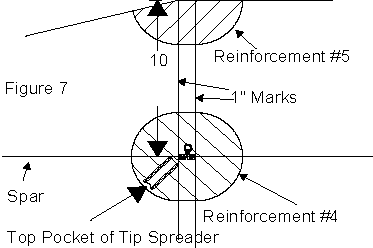
A) Take a piece of the 2” wide strip and cut it 2½” long.
B) Fold all edges over ¼”.
C) Position this on reinforcing #4 so that it points towards reinforcing #6, and is 10” from the top of the sail.
D) Sew 3 sides leaving the 1 pointing towards reinforcing #6 open.
E) Repeat for other side. - Finishing Sail
A) On the front side of the Sail run a length of Seamstick (1/4” wide double-faced tape) from the top to the bottom on the outside of one of a set of 1” marks.
B) Place the Top Keel over the tape aligning the sewing marks, making sure the top of the Keel aligned with the top of the Sail.
C) Repeat from Bottom Keel lining up the bottom of both
D) Place Seamstick over the Keels.
E) Fold over the Sail lining up the 1” marks.
F) Sew using a straight stitch.
G) Remove Seamstick.
H) Repeat for other set of 1” marks - Frame
A) Assemble frame as shown in Figure 8.

Make sure that CT3150 is centered and through the Spreader Spar Holders.
B) Insert the .1800 Spines into pockets formed by 1” marks. - Bridle the kite as
shown in Figure 9. It is called a Compound Bridle
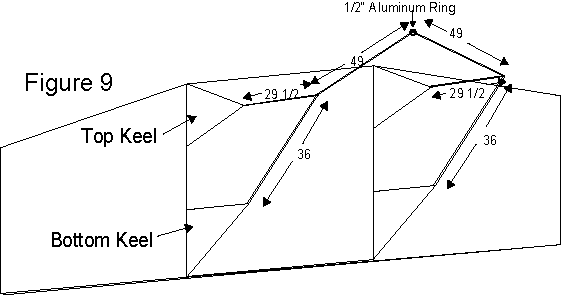
- Bow Line
A) Tie a loop in one end of a 14’ piece of 100# bridle line
B) Hook loop onto arrow nock (YSP-63).
C) Run this thru the line tensioner.
D) Pass the free end over other arrow nock
E) Tie off to line tensioner
F) Adjust so the spreader is bowed backwards about 8”
Instructions and Diagrams Copyright 1999 Mike Dallmer
South Jersey Kite Flyers, PO Box 32, Collingswood, NJ 08108-9998 SJKF (sjkf@geocities.com)